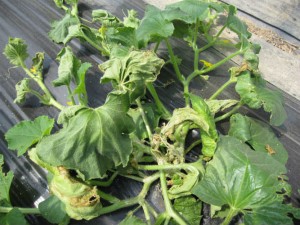What Is It? | Facts in Depth | For the Professional Diagnostician
Cucurbit Diseases | Bacterial Wilt
Bacterial Wilt
Symptoms
Symptoms begin in individual leaves, where they suddenly wilt and eventually shrivel (Smith, 1911). Early in the disease, leaves may “droop” during the heat of day but revert to normal in the evening or under cooler conditions. Leaves show a darker green color around the infected area and a few leaves show wilt along the stem. As wilting progresses, the xylem vessels inside the stem collapse and are discolored. Eventually, the entire plant turns to a dull green color, collapses, and eventually dies (Smith, 1911; Koike et al., 2007).



(Left: Melon; Middle: Zucchini; Right: Pumpkin)
Signs
When the stem is cut along the base, clear to white elastic strands comprised of Erwinia tracheiphila and “gum” are visible when cut ends of stems are slowly pulled apart (Latin, 2000). See the video below under the heading “Rapid Diagnostic Tests” to see an example.


Often Confused With
- Squash vine borer damage – Plants begin to wilt and eventually collapse, if not treated, which closely resembles the symptoms caused by Erwinia tracheiphila; however, squash vine borers cause very different damage than the cucumber beetles. Small borer holes near the base of the plant contain a green to orange sawdust-like material (insect frass) inside the stems.
- Fusarium root rot – Plants begin to wilt; however older leaves are usually the first to exhibit symptoms, followed by the younger foliage. The foliage becomes very chlorotic. There is also some vascular discoloration, but this discoloration appears as long brown streaks.
Culture Media for Erwinia tracheiphila Isolation from Plant
- General bacterial media, such as Nutrient Broth Yeast Extract (NBY) with 0.5% dextrose
- Nutrient Agar (NA) (Saalau Rojas et al. 2013)
Rapid Diagnostic Tests
PCR Assays
- Mitchell and Hanks, 2009: ETC1 and ETC2 (5’ GCACCAATTCCGCAGATCAAG 3’ and 5’ CGCAGGATGTTACGCTTAACG 3’) with an expected fragment size of 426 bp.
- Bruton et. al., 1999: ET1 and ET2 (5′ TGAGTTCCCGACCAAAT 3′ and 5′ GGGAGGAAGGGACGCTG 3′) with an expected fragment size of 710 bp.
- Sasu et. al., 2010: Et73 and Et140 (5’ GGCGATCACGACACAGTTGT 3’ and 5’ CAGTTTTTGGTCAGGGCATACTC 3’).
Presence of Bacterial Ooze
Cut at the base of the stem and pull the two cut pieces slowly away from each other. If the plant has bacterial wilt, white to clear elastic strands of bacterial ooze stretch out between the two cut pieces. This test is definitive for bacterial wilt identification when one or more strands are observed. However, lack of a strand is not a confirmation of lack of disease, especially when the stems are dry or early in disease progress.
